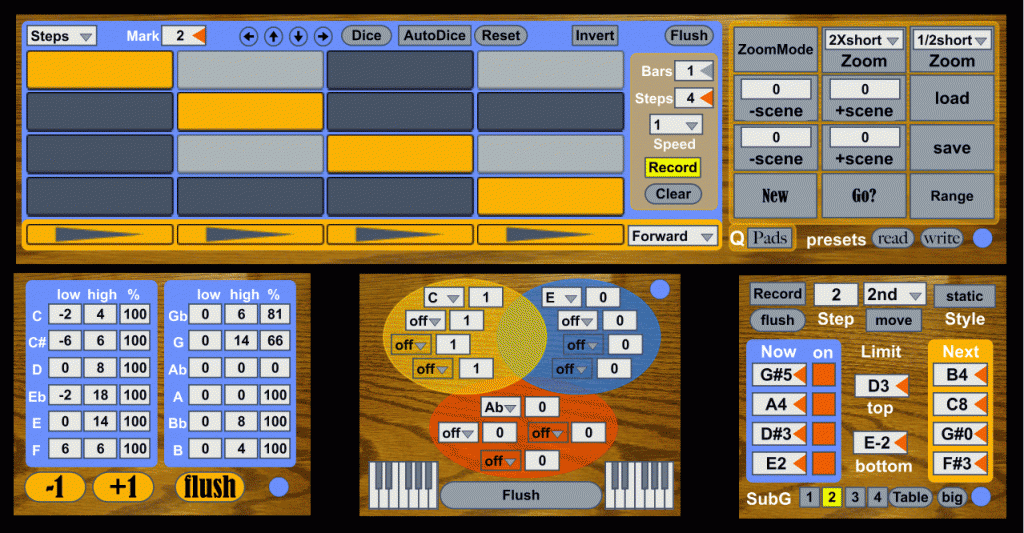Suite of M4L patches for David Virelles
This is a suite of 4 Max for Live patches built for David Virelles to use with his Akai MPK48. Each patch is designed to process midi data, the large patch at the top of the image performs a variety of functions dealing with timing and the three patches at the bottom are focused more on pitch processing. David is a pianist so each patch has been built with that type of midi input in mind. Here are brief descriptions of each of the patches:
Ritmo: The large patch at the top of the image allows you automatically record a new clip of any length or meter in Ableton while simultaneously filling a buffer inside the patch by simply tapping a pad on the MPK48 or pressing the corresponding “New” button. The buffer is fully polyphonic and stores all velocity data as well as note number.
Once the buffer is full, the user can divide the buffer into a specified number of equal or unequal steps and rearrange the playback order, direction, and muting of the buffer contents. Pressing the “Range” button or corresponding pad on the MPK48 causes semi-transparent colored bars to appear over the grid of steps and allows the user to quickly change the duration of each step by adjusting the knobs at the top of the MPK48. Pressing “Dice” randomly rearranges the order of playback and engaging “AutoDice” causes the “Dice” button to be pressed whenever the last step on the grid is reached.
Turning on “Invert” converts all note-on messages to note-off messages and vice versa. Changing “Speed” changes the speed of playback multiplicatively by values of .5, .75, 1.0, 1.5 and 2.0.
Pressing the “ZoomMode” button or corresponding pad on the MPK48 causes a semi-transparent orange block to appear over the grid and allows the user to select a number of steps that can then be effected by the two “Zoom” buttons or corresponding pads on the MPK48 to the right of the “ZoomMode” button. Once an area is selected, the user can perform one of the four types of zooming.
“2Xlong” doubles the speed of performance data in a particular area, thereby shortening the length of that passage by half, but it then copies that passage into the second half of the initially selected area, resulting in a passage doubling in speed and playing twice. “2XLong” also doubles the speed of performance data in a particular area but does not copy that passage, resulting in a doubling of speed, cutting the passage in half and leaving the second half of the selected passage intact.
“1/2long” slows the speed of performance data by half resulting in a doubling of length of performance that is allowed to overwrite any date in the following area. “1/2short” slows the speed by half but the resulting dating is not allowed to overwrite data in the following area resulting in the data in the second half of a selected are to be eliminated.
Configurations of the grid, direction, “AutoDice”, “Invert”, and “Speed” can be stored and recalled as presets using the buttons labeled “load” and “save”.
Transpose: The patch at the bottom-left of the image is designed to transpose notes by octaves. The likelihood that a particular note will be transposed is controlled by setting “%” chance that the note will be transposed. The number of octaves that a note will be transposed by is chosen randomly within a range set by the “low” and “high” number boxes. The “-1″ and “+1″ buttons allow the user to quickly shift all range values up or down by one.
There is another version of this patch (not shown in the image) that transposes by half steps rather than by octaves. This version of the patch obviously does not retain tonality as the octave version does.
MatrixZones: The patch at the bottom-center of the image allows the user to set up three groups of notes so that anytime the patch receives a note, there is a chance that it will play a different note from the same group instead. The likelihood that a particular note will be triggered is controlled by the number box to the right of that note. The higher the number is relative to the other notes in it’s group the more likely it is that it will play. Incoming notes are displayed on the keyboard to the left and outgoing notes are displayed on the keyboard to the right.
4-Voice Pitch Mutation: The patch at the bottom-right corner of the image allows the user to sustain a four note chord by pressing “Record” and sending four notes to the patch. Once the patch has received four notes it creates a 16 step table in which individual voices are selectively allowed to shift from one step to the next. The user uses a grid (not shown) to decide when voices are allowed to shift. The table of pitches is divided into four sub-groups consisting of four steps each.
In “static” style the patch will sustain any pitches turned “on” and if “move” is turned on, the patch will cycle through the pitches of any sub-groups that are turned on. In “dynamic” style, the patch will selectively allow the voices to continue shifting pitch based on the aforementioned grid.
Setting the “top” and “bottom” “Limit” keeps any voice from wandering too far by ensuring that a voice will shift down anytime it creates a pitch above the “top” limit and will shift up anytime it creates a pitch above the “bottom” limit.
Pushing the “big” button causes a large window to pop-up that displays the currently playing pitches shown in the “Now” column and the next pitches that will play shown in the “Next” column so that it is easy for a group of musicians to glance at the screen from a distance and know what pitches are playing and which pitches are about to play.


